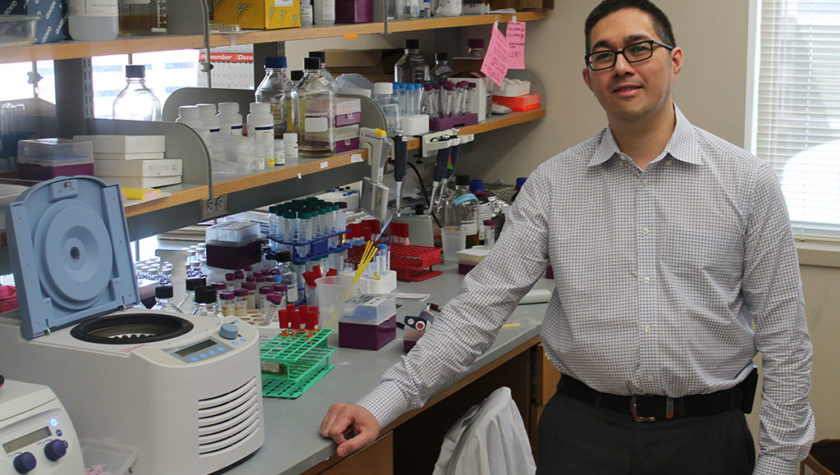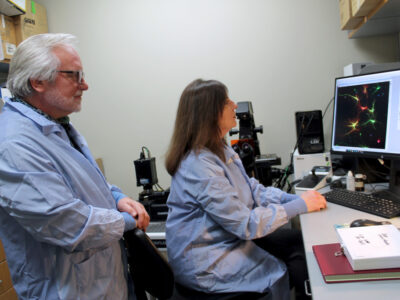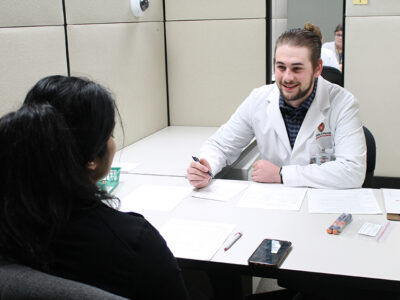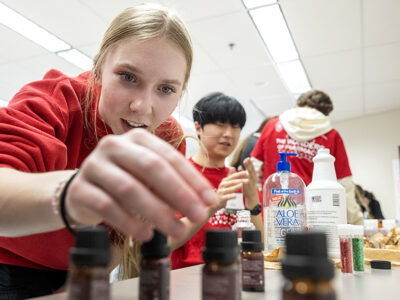
7
December

With NIH funding, Assistant Professor Jason Kwan explores new methods to discover drug candidates
By Mary Magnuson
“It was a real shock to me to learn in pharmacy school that a lot of these drugs we use are made by bacteria,” says Jason Kwan, an assistant professor in the University of Wisconsin–Madison School of Pharmacy’s Pharmaceutical Sciences Division. “And not only that — they have incredibly weird and wonderful structures that no synthetic chemist would ever think to make if it weren’t for natural molecules like that.”
Since that initial spark for natural products research, Kwan has become a leading researcher in the field, even earning a prestigious Faculty Early Career Development (CAREER) award from the National Science Foundation earlier this year, which is granted to the country’s top young faculty in support of innovative research and their development as academic role models. Through that award, he began work to develop new bioinformatics approaches to explore microbial communities.
Now, through a new five-year R35 Maximizing Investigators’ Research Award (MIRA) from the National Institutes of Health, he will be developing new ways of discovering and obtaining small molecules from cultured and uncultured natural sources, which will ultimately increase the new drug candidates that can be used to treat conditions ranging from bacterial and fungal infections to cancer.
Kwan studies a variety of organisms, from beetles to aquatic creatures, but one thing they all have in common is a symbiotic relationship with different bacteria. These bacteria produce compounds to benefit the host organism, and many of these compounds could have antibiotic uses in humans, Kwan says.
Because of the growing problem of antibiotic resistance Kwan said it’s important to explore other sources of potential antibiotics in order to treat resistant infections. Although there are is an estimated 1 trillion species of bacteria, the vast majority of antibiotics trace back to a single phylum: actinobacteria. Because of established methods to grow actinobacteria from environments such as soil, they have been so well-mined that when scientists return to them in search of a new potential antibiotic, 99 percent of the time, they rediscover an existing compound.
“There are lots of interesting innovations that can be made from looking at how evolution has solved certain problems.”
—Jason Kwan
However, since bacteria involved in the host-symbiote interactions that Kwan is exploring aren’t as “well-mined” or as heavily studied as actinobacteria, there’s a much higher chance of discovering new potential antibiotics, Kwan says. Importantly, looking in underexplored environments increases the chances of finding novel structures — unlike the many derived from actinobacteria — meaning bacteria wouldn’t already have resistant strategies in place.
“There are countless bacterial species that we can’t actually grow in the lab,” Kwan says. “For example, a lot of bacteria that make interesting molecules are unculturable because they’ve been in a symbiotic relationship with a higher organism like a beetle for millions of years.”
Through the MIRA grant, one of the strategies Kwan will be using to make new molecules from these uncultured bacteria is directed evolution, to aim to narrow that million-year gap. Another way is through sequence analysis.
The Kwan Lab uses culture-independent metagenomic sequencing, a technique that allows him to examine these natural, biological compounds and how they’re created by their environment. When harvesting samples from soil, or an insect host, the molecular sample will likely be contaminated by DNA or RNA from the other organisms in the environment, which means sequencing DNA can result in a confusing jumble of DNA fragments. With metagenomic sequencing, however, Kwan uses additional data analysis to piece together bits of genetic code from thousands of organisms at ones and examine the ways they interact.
Through the bioinformatics work his CAREER award enabled, Kwan also sought to enhance metagenomic analysis — which, in many ways, is similar to putting together a jigsaw puzzle made of a few billion pieces.
While the process isn’t perfect, Kwan says it’s a step forward because out of the trillion bacterial genomes that likely exist, each bearing unique adaptations to challenges found in nature, only a miniscule portion have been explored.
“There are lots of interesting innovations that can be made from looking at how evolution has solved certain problems. A lot of the problems that bacteria have growing in a mixed environment are kind of similar to problems we have in terms of infection,” Kwan says.







